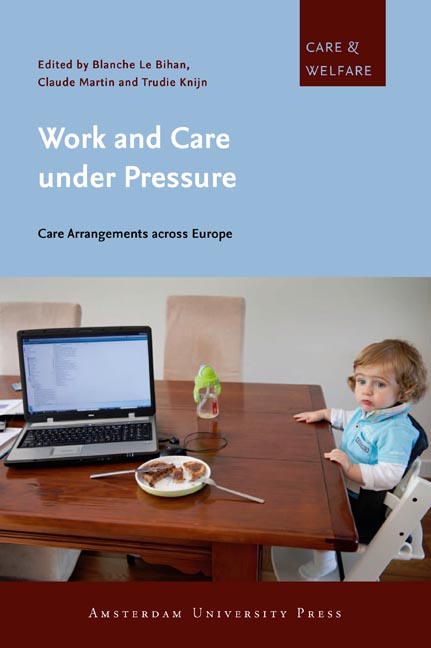Book contents
- Frontmatter
- Contents
- 1 Introduction: Workers under pressure and Social care Arrangements: A Research Framework
- 2 Work-family Balance in the Netherlands: Work and Care Culture Mediating Between Institutions and Practices
- 3 Negotiating Gender Equality, Atypical Work Hours and Caring Responsibilities: The case of Sweden
- 4 Caregiving and Paid work in Germany: The Impact of Social Inequality
- 5 Working Caregivers ‘Living Under Pressure’ in France
- 6 Negotiating Work and care in a Changing Welfare Regime: The case of Portugal
- 7 Blurring Boundaries and Clashing Loyalties: Working and caring in Italy
- 8 The changing mix of care in six European Countries
- About the Contributors
- Care & Welfare
8 - The changing mix of care in six European Countries
Published online by Cambridge University Press: 06 January 2021
- Frontmatter
- Contents
- 1 Introduction: Workers under pressure and Social care Arrangements: A Research Framework
- 2 Work-family Balance in the Netherlands: Work and Care Culture Mediating Between Institutions and Practices
- 3 Negotiating Gender Equality, Atypical Work Hours and Caring Responsibilities: The case of Sweden
- 4 Caregiving and Paid work in Germany: The Impact of Social Inequality
- 5 Working Caregivers ‘Living Under Pressure’ in France
- 6 Negotiating Work and care in a Changing Welfare Regime: The case of Portugal
- 7 Blurring Boundaries and Clashing Loyalties: Working and caring in Italy
- 8 The changing mix of care in six European Countries
- About the Contributors
- Care & Welfare
Summary
A multidimensional approach to care
Care arrangements have changed significantly in Europe over the last 40 years in the context of shifting gender cultural models, labour markets and welfare systems. While policies introduced immediately after World War II were largely based on a male breadwinner/female home caregiver model, post-1970s policies have emphasised a move away from male breadwinning and an increase in female employment rates and greater state responsibility for working caregivers through leave systems and services. Schemes involving leave to care for the elderly or other family members, early educational services for young children and services/institutions to support elderly persons – even if diverse in structure, intensity and prevalence – are now available in all EU countries.
Two issues may be raised regarding the changing nature of care arrangements and how to conceptualise them. The first is whether these changes have shifted away from familialised care arrangements based on unpaid female and informal homecare, thereby reinforcing individual autonomy in relation to the provision of family care as well as gender equity in employment and care work. Welfare state literature and literature on gender and work-family balance reveal complex and often contradictory consequences of these changes. On the one hand, paid leave systems and publicly subsidised services are generally seen to have promoted a trend towards de-familialisation and a decline in male breadwinning/ female caregiving, especially in the Nordic countries in the 1980s and early 1990s, by integrating children and dependent persons in care services/institutions and promoting gender equity in care (Leira 1992; Sainsbury 1999). Some of this literature suggests a more or less linear move from a female caregiving model towards a dual earner/dual caregiver model, while other scholars point towards a predominant ‘adaptive’ model in which preferences go towards part-time work or temporary absences from the labour market for certain periods or life stages in order to devote oneself to caregiving (Treas & Widmer 2000; Hakim 2003).
On the other hand, the diversity and increasing complexity of current care arrangements and policies have also been highlighted over the last decade (Geissler & Pfau-Effinger 2005). Rather than a unidirectional linear move, much of the literature on gender and work-family policies has emphasised the emergence of a plurality of care models and spheres of care in which it is difficult to find a clear distinction between familialised/ gendered and de-familialised/de-gendered arrangements (Gornick & Meyer 2009).
- Type
- Chapter
- Information
- Work and Care under PressureCare Arrangements across Europe, pp. 171 - 194Publisher: Amsterdam University PressPrint publication year: 2013

